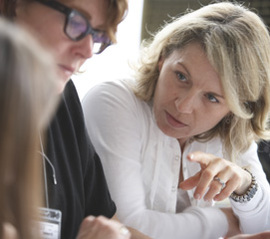Competency Models
Professional Competency
Currency, Relevancy, Creativity, & Connections
Professional Competency: Actively contributes to, and learns from the best industry practices in order to provide students with a relevant education.
- Demonstrates understanding and mastery of established and emerging industry practices and their importance to FIT graduates.
- Demonstrates currency and active engagement in the profession of one's primary teaching discipline.
- Engages in creative or scholarly activities within one's discipline, industry, or profession.
- Models professional behavior that prepares student for entry into a profession.
- Utilizes mentorship and apprentice techniques to shape student's growth and preparation for a profession.
- Creates and maintains a network of alumni and industry experts who can be called upon as resources for course and curriculum development, focus groups, guest speakers, internships, and placement opportunities for students, etc.
- Maintains positive, helpful, supportive, respectful, collegial, and teamwork-oriented relationships with other professionals.
- Supports FIT, its mission, goals, and initiatives through both classroom and non-classroom activities.
Technology Competency
Technology Literacy, Instructional Technology, Technology in the Profession
Technology Competency: Understands, appreciates and uses technology to enhance student learning, engagement, and preparation for entry into a profession.
- Incorporates instructional technology into delivery of course material and learning experiences.
- Utilizes learning experiences that expose students to the uses of technology in their chosen discipline, industry, or profession.
- Appropriately uses technology to communicate with, and engage students in, learning outside of the classroom.
- Understands and appreciates the advantages and limitations of using technology for compiling, organizing, analyzing, and synthesizing information.
- Effectively uses technology and electronic information to enhance one's professional productivity such as communicating, collaborating, conducting research, solving problems, and enhancing personal performance.
- Demonstrates an awareness of adaptive assistive devices and technologies available to meet the inclusion of special needs students or students with different learning styles.
Learning Enrichment Competency
Instructional Delivery, Information Literacy, Inspiration, Engagement
Learning Enrichment Competency: Demonstrates teaching practices that advance and enhance student learning and success.
- Possesses the ability to utilize a variety of instructional delivery methods to improve student learning.
- Embraces and utilizes emerging forms of pedagogy, where appropriate, such as team teaching, online teaching, interdisciplinary methods, active learning, etc.
- Teaches students how to integrate, synthesize, and utilize information from various disciplines.
- Teaches students information literacy skills and how to identify, locate, select, organize, evaluate, and present information appropriately.
- Assists students in developing critical thinking, problem-solving, and communication skills, as well as critical analysis and thoughtful skepticism.
- Encourages student interaction, collaboration, teamwork and cooperation in the learning process.
- Demonstrates the ability to inspire student interest, curiosity, imagination, creativity, and love of learning.
- Exhibits a love of learning.
- Develops expertise in multiple areas over one's career as disciplines and industry change.
- Demonstrates the ability to support different student learning styles and abilities.
- Supports student development and success through curricular, co-curricular and extracurricular activities.
- Embraces the emerging roles of faculty as facilitators, mentors, integrators, and decipherers of information and knowledge.
Instructional Design Competency
Instructional Design, Interdisciplinarity, Active Learning, Theory to Practice
Instructional Design Competency: Creates an optimal learning environment through purposeful selection of learning experiences and curriculum.
- Designs and delivers course content that reflects a balance between classic thought, contemporary practice, and the state of the art in one's field.
- Designs and delivers coursework in a manner that links learning objectives across disciplines and reflects how work is performed in industry.
- Integrates course concepts with related curricula, disciplines, and professional practice.
- Designs and delivers course work that integrates knowledge in the context of an art and design school.
- Balances both theory and the practical application of knowledge, to include building skills that are necessary to be successful in a profession.
- Creates learning experiences that require collaborative exercises, real world problem-solving, and a skills-based approach to learning.
- Adapts course content to adjust to changing industry, global, and consumer trends while respecting local issues and challenges.
- Designs classroom and other learning experiences that foster critical thinking, problem solving, information literacy skills, and creativity.
- Uses instructional variety in order to accommodate students of different learning styles, abilities, demographics, or diversity.
- Maintains connection to industry that allows integration of professional practice with classroom learning.
Globalism Competency
Globalism, Diversity, Multiculturalism, Pluralism
Global Competency: The knowledge and skills to comprehend and explain globalization, to integrate information across disciplinary domains and to prepare students to understand global affairs and events in a multicultural and diverse environment.
- Demonstrates an awareness of global issues and their impact on one's discipline, industry, or profession.
- Demonstrates an understanding of the international connections within our local and regional community.
- Demonstrates the ability to work effectively in international settings, with colleagues regardless of location, or background.
- Values working within the NYC creative district and uses its potential to enrich student learning experiences.
- Understands how the arts and the disciplines of design can benefit humanity, society, and the environment.
- Possesses an authentic understanding of worldwide needs and how FIT disciplines can address these needs, as well as using global knowledge to provide service to our local community.
- Shows appreciation for cultural diversity and has a positive approach to cultural differences.
- Demonstrates the ability to work within, support, and maintain productive relationships in multicultural environments and models inclusive behaviors for students.
- Demonstrates awareness and sensitivity to all racial, ethnic, religious and social groups, and incorporates this understanding into teaching and learning experiences.
- Has the ability to communicate across cultural and linguistic boundaries.
- Speaks, understands, and thinks in other languages.
- Demonstrates the ability to recognize and balance differing worldviews based upon a deep knowledge and awareness of other people, countries, cultures and beliefs.
- Incorporates the values of sustainability and ecology into the learning process.
